What is Digital Dentistry?
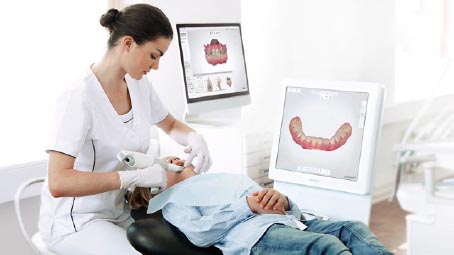
Digital dentistry is a broad term encompassing any dental technology that involves the use of computer-based components such as hardware devices and software solutions. The purpose is to enable dental professionals to deliver treatment with the help of computer-aided tools. New possibilities such as digital scanning in dentistry enable dentists for example to take impressions, perform diagnostics or plan treatment without the use of mechanical tools. Digital dental solutions for labs such as impression scanners and design software significantly speed up the process of creating high-quality dental products and reduce the amount of manual work.
The history of digital dentistry does not stand alone — it saw daylight for the first time when French dentist Dr. Francois Duret applied principles of CAD/CAM (computer-aided design/computer-aided manufacture) for dental impression taking in 1984. Since that day, dental professionals from many countries around the world have invented and patented a lot of digital dental solutions to optimize the dental treatment process. Nowadays around 85% of dental clinics globally still take impressions the conventional way: with an impression tray.
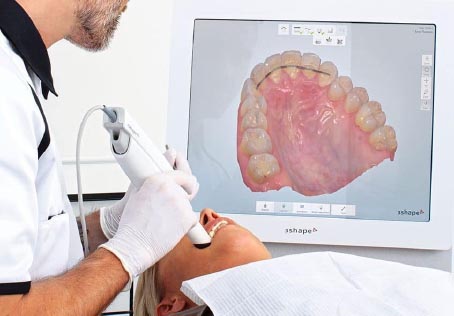
Digital Technologies in Dentistry
Digital dental technologies available for dental clinics or labs have a wide range of purposes. Imaging, scanning, digital design and 3D printing or milling are technologies developed on their own but complement each other for treatment planning, design and delivery of the final product. Dental processes and scanning technologies (like intraoral or impression scanning and supporting software solutions) help to improve strength and esthetic qualities of restorations, as well as decrease costs and improve practice efficiency.
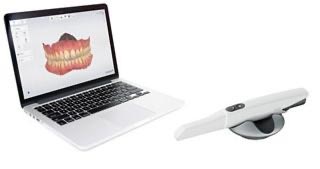
Scanning Equipment in Digital Dentistry
Digital scanners in dentistry can be classified into different types depending on where and how they are used: in dental clinics, facing the patient, or in dental laboratories, not facing the patient. Dental scanning equipment for clinics can be categorized into CBCT or intraoral scanners. Dental Cone beam CT (CBCT) scanners are used for taking X-rays of the mouth area, and intraoral scanners or dental 3D scanners replace the conventional impression method, where patients are asked to sit with gooey impression material in their mouth in order to get an accurate impression. The two scan types can be combined for example when full denture treatment is needed.
Intraoral scans are built up by polygons and can be combined with an image taken by an intraoral camera. The result is a realistic 3D image of the patient’s dentition on a computer screen or tablet, and allows the dentist to see even the smallest problems and defects of teeth, and other parts of the cavity, that cannot be noticed with the naked eye. Some scanners can even detect caries in the very early stages (which also helps to prevent its further development).
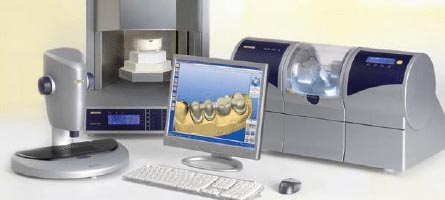
CAD/CAM in Digital Dentistry
Computer-aided design (CAD) and computer-aided manufacturing (CAM) technology refer to the software solutions used, for dentistry but also for other fields such as automotive. Even though technically, CAD/CAM refers to the design and manufacture phases, in day-to-day conversation, the CAD/CAM process covers everything from intraoral scanning, creating a digital dental design, its milling or printing, and implementation into the mouth. This process can be as quick as 40 minutes and can for example enable single-visit treatment. Research points out that CAD/CAM solutions such as scanning and using dental design software can make treatment more accurate, faster, cheaper and decrease the burden on the patient.
This dental software may be used by doctors, specialists and lab technicians to construct restorations or prostheses (for example dentures or bridges, inlays and onlays, veneers, crowns, and others), create dental designs, and work on the dental treatment planning cases. These solutions help plan, design and manufacture in a way that is speedy, predictable and easy for the patient to assess. The work done in CAD/CAM software is done on the basis of an intraoral or impression scan — with the software helping with most of the design work.
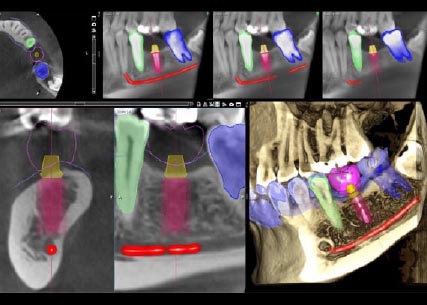
Digital Restorative Dentistry
Digital technology in implant dentistry caused an unparalleled revolution in how dentists plan, design, and manufacture restorations, dentures, and implants, and how they can now treat patients. These days, a digital workflow in implant dentistry has almost fully eliminated manual processes.
For instance, dentists resort to the latest digital dentistry innovation for implantology treatment by using so-called implant surgical guide technology when installing the implant. Another field of dentistry where the revolution is apparent, is in edentulous cases: for these patients their treatment outcome is fully transparent and they can see exactly how their smile will look after the completion of treatment. Technologies for virtual smile design are not only revolutionizing dental practitioners' lives, they also do so for patients.
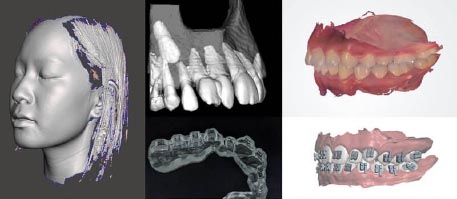
Digital Orthodontic Treatment
The way dentists can treat malpositioned teeth, jaws, and misaligned bite patterns are brought to a whole new level with digital orthodontic care technologies. Traditional panoramic X-ray and manual methods of teeth position examination are not as accurate as impressions taken with digital dental scanners (however in some cases they can still be combined).
In digital orthodontics, 3D computer visualization helps to create a detailed model of the teeth and bites from different angles and choose the best positions for braces, invisible aligners, or other appliances.
Digital models in orthodontics also save a lot of time for design, manufacturing, and transportation since the treatment appliance can instantly be manufactured in-house (previously, clinics had to create plaster cast, which takes up a lot of space and at the same time, could damage during transportation).
Digital impressions in orthodontic treatments also have benefits for patients since it's no longer needed to experience the unpleasant gooey materials and spend hours in a dental chair.
Solutions used in the orthodontic digital workflow are applied for the following indications:
- Alignment and movement of crowded or spaced-out teeth.
- Correction of bite.
- Restoration of missing teeth.
- Correction of the teeth growth.
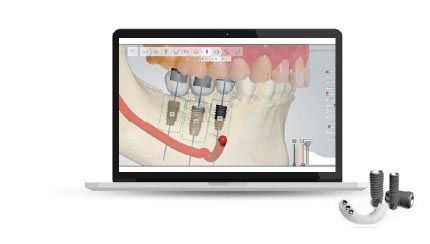
Advantages of Digital Dentistry
It’s possible to present the final result to a patient even before treatment starts (when using a dental smile design protocol, for example), engage in dialogue with them around their expectations, and adjust the plan based on their wishes regarding the esthetics and the treatment timeline.
More accurate treatment planning: Software solutions for dental treatment planning enable designing and planning with digital precision and accuracy, which is a good way to minimize errors (for instance, recording occlusion ensures a better fit).
Time-saving: Digital solutions allow dentists to take impressions quicker and give patients the option to get treatment in a single visit, with less chair-time for the patient.
No more gag-reflex: Dentists taking traditional impressions are often faced with the patients’ gag-reflex or teeth hypersensitivity to cold washing agents. The discomfort of conventional impression taking can be avoided by taking impressions digitally.
Entertainment: Digital pediatric and orthodontic dentistry can help children experience dental procedures as less stressful. Their 3D image on screen — looking like a video game — helps them understand what’s happening.








